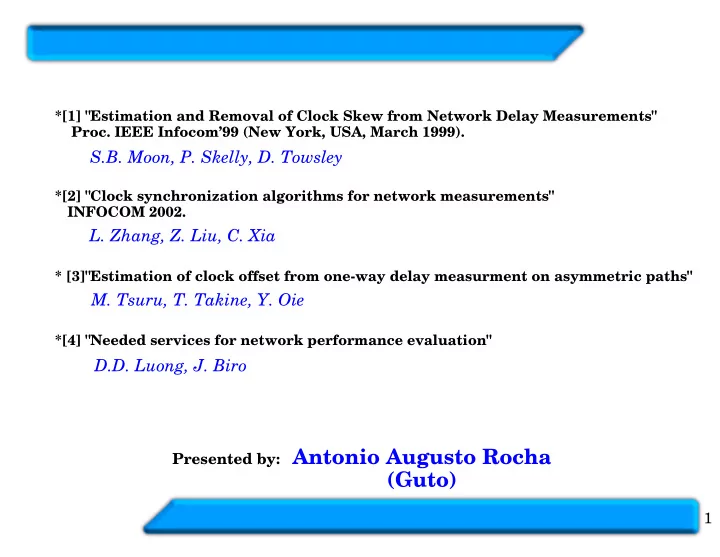

*[1] "Estimation and Removal of Clock Skew from Network Delay Measurements" Proc. IEEE Infocom’99 (New York, USA, March 1999). S.B. Moon, P. Skelly, D. Towsley *[2] "Clock synchronization algorithms for network measurements" INFOCOM 2002. L. Zhang, Z. Liu, C. Xia * [3]"Estimation of clock offset from one-way delay measurment on asymmetric paths" M. Tsuru, T. Takine, Y. Oie *[4] "Needed services for network performance evaluation" D.D. Luong, J. Biro Antonio Augusto Rocha Presented by: (Guto) 1
Presentation format 4 papers to present Different format in this presentation Not a full paper Methods proposed, pointing the papers Overview: Clock Terminology Define the Clock´s problems Explain the methods proposed to solve each problem Traffic Generator Experiments/results with TG Conclusions and considerations 2
Clock Terminology C : represent the clock of machine X; x Frequency: Growing rate of clock C ; x C (t): Instant "t" in clock C ; x x t and t : Instants "t" of sending and receiving a packet; s r Suposed Delay = C (t ) - C (t ); r a b s 3
Problems With GPS that is valid; If NOT, the function D= C (t ) - C (t ) is NOT valid; r a b s Some problems must be considered: The frequency of clocks ( C’ and C’ ) are not the same : SKEW a b The difference between the clocks at intant "t" may be different of zero C (t ) != C (t ) : Offset s a b s The difference of clocks rate (frequency) may change, skew change: Drift The clocks may be abruptly shifted (UPDATE): Shift The O.S. break may cause noises in the results: Noise 4
Skew The difference in the clocks frequency cause a tendencius growing in the trace. Figure show this event, x-aix (# seq of pack) and y-aix(delay) 1.6516e+08 1.6514e+08 1.6512e+08 1.651e+08 1.6508e+08 1.6506e+08 1.6504e+08 0 1000 2000 3000 4000 5000 6000 Algorithms proposed in [1,2] try to solve this problem. Find a line All trace points cover this line As close as possible from those poitns 5
Skew (cont.) [1] propose a algorithm, based on linear programming, to solve the problem In this proposal, try to estimate parameters: Many possibilities. the objective function minimizes the sum of the distance between the line and the data points. 1.6516e+08 1.6514e+08 1.6512e+08 1.651e+08 1.6508e+08 1.6506e+08 1.6504e+08 0 1000 2000 3000 4000 5000 6000 6
Skew (cont.) [2] propose an algorithm to solve this problem based on computation of the convex hull. Convex Hull (all points) Estimate Points X, line cover X is used. 1.6516e+08 1.65015e+08 1.6501e+08 1.6514e+08 1.65005e+08 1.65e+08 1.6512e+08 1.64995e+08 1.6499e+08 1.651e+08 1.64985e+08 1.6498e+08 1.6508e+08 1.64975e+08 1.6506e+08 1.6497e+08 1.64965e+08 1.6504e+08 1.6496e+08 0 1000 2000 3000 4000 5000 6000 1.05067e+15 1.05067e+15 1.05067e+15 1.05067e+15 1.05067e+15 1.05067e+15 1.05067e+15 1.05067e+15 1.05067e+15 1.05067e+15 1.05067e+15 7
Offset The difference between the sender and the receiver clock introduce a fake value in the delay computation This value may be so different resulting in a "packet being send after received" [3,4] propose a method to solve this problems: Exist other proposal, but they do NOT consider the possibility of asymmetric path. Asymmetric path = different capacity of transmission along the path. 8
Offset (cont.) The algorithm variate the packet size of probes, in both directions, and take the minimal value (without SKEW) for each sample size. Identify a linear decrease. the diference of the points when both lines touch the y-aix, is considered twice the offset value. This simulate a packet of size zero, or propagation time. 9
Drift Changes in the clock frequency It is possible SKEW change; Unvalidate the Skew estimation; NTP change the Drift of a clock: First time the Clock is sincronized Drift clocks are adjusted to keep sincronization 1.6516e+08 1.6516e+08 1.6514e+08 1.6514e+08 1.6512e+08 1.6512e+08 1.651e+08 1.651e+08 1.6508e+08 1.6508e+08 1.6506e+08 1.6506e+08 1.6504e+08 1.6504e+08 0 1000 2000 3000 4000 5000 6000 0 1000 2000 3000 4000 5000 6000 10
Shift Caused by a clock adjust in one of the two nodes; In the trace, an abrubt shift in the delays; Figure(A) It can cause a wrong skew estimation; Figure(B) [2] propose a way to estimate SKEW with Shifts in the trace. Problems with this proposal; Traffic Generetor has a solution implemented, we are comparing both; 11
Noise Not in any paper, and not in the literature We experimented this problems in ours traces Caused by a Operational Sistem break Consequence is noises in the trace, Figure shows the exemple; Option: Ignore -> Could bring problems in the delay distribution estimation, it could be the responseble by the LONG TAIL of a distribution. Remove -> The Traffic Generator is implementing a method to consider this noises (O.S. breaks). 12
Traffic Generator Tool to estimate end-to-end caracteristics One-way delay Implemented algorithms proposed by [2,3] (Skew and Offset) Methods proposed by us (Shift, Noise) 13
Estimating Delay Distribution Tool try to estimate the delay distribution Used in the Don’s Class 14
Conclusion and Considerations The methods proposed are good solution to estimate delay without Sinchronization equipaments Estimate the parameters in One-way is very important, the "round trip way" do NOT consider the differences between the ways. Traffic Generator is a unique tool for estimating end-to-end network caracteristics The tool has been usefull to: Increase the quality of some multimidia application produced by the lab. Create more realistics models to be simulated Know the caracteristics of our National Research Network 15
END... Thanks!!! 16
Recommend
More recommend